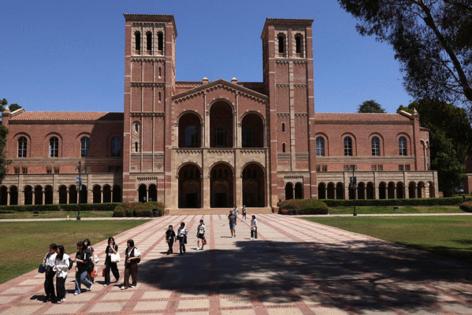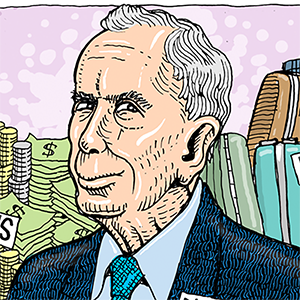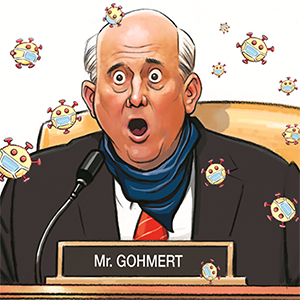Students oppose UC tuition hikes. Leaders say campuses need money in the Trump era
Published in News & Features
LOS ANGELES — University of California regents — facing an uncertain financial outlook amid Trump administration cuts, a significant reduction in state funding and growing inflation — will vote this week on whether to increase tuition and put aside a smaller portion of that money for financial aid.
The highly anticipated vote on Wednesday has generated intense opposition from students. Student government leaders from all nine undergraduate campuses plan to protest outside the regents' meeting at UCLA to oppose the hikes and intend to make a long-shot plea for no increases.
"Rally against the UC! Stop tuition hikes. Debt is not a rite of passage," reads a social media post from the UC Student Assn., which represents 236,000 undergraduates from Davis to San Diego.
UC leaders say the proposal renews an existing policy assuring "tuition stability" for entering students, locking in their tuition rate for up to six years of study while generating enough money to sustain the system during financially unstable times. Supporters say the policy benefits cash-strapped students, ensures continued financial aid and allows parents to plan long term for education costs.
The original program, which was passed four years ago and expires next year, also faced strong opposition. But UC says that it has resulted in lower tuition rates when compared to tying costs strictly to inflation.
Leaders say growing enrollment coupled with financial strains — UC recently requested a $130-million zero-interest loan from California to make up for lost state funds — has made the annual increases more urgent.
Instructional spending per student has decreased when compared with levels 20 years ago, UC said. The student-to-faculty ratio has worsened. Staff support for students and faculty has not kept up with enrollment and salaries for tenure-track faculty lag behind university goals. In addition, campuses are grappling with backlogs of deferred maintenance.
Caín Díaz, UC's associate vice president for budget analysis and planning, said in an interview Monday that renewing the plan will provide more stability and predictability not only to students, but also to the university budget.
Before the stability program, he said, "we had gone more than a decade where there was really only one or two years of an increase. Prior to that, it was very inconsistent."
"What the plan was helpful for is creating that stability on a funding source that represents basically half of total core revenues for the university, and saying, at least on this, we can count on the regular, modest increases that are pegged to inflation. Approaching this from a long-term perspective is helpful while still being mindful of the immediate challenges that we're seeing from operational cost growth to the state budget to federal actions," Díaz said.
Aditi Hariharan, a UC Davis undergraduate and president of the UC Student Assn., said she believed other solutions to UC's financial predicaments were possible.
"We're opposed to all increases because a UC education is already un-affordable for so many students," said Hariharan. "This model essentially has created forever tuition hikes, with a tuition hike happening every single year, and without a vote being required by the Board of Regents each year. So what we want, if there must be increases, is more oversight and more student input into how these fees are being used and who these changes are affecting."
How does the tuition hike work?
In 2021 — after years of debate, protest and delay — UC raised tuition and introduced a program to lock in costs for undergraduates tied to the year they first enrolled.
Undergraduate students from California who entered in the fall of 2022 — most of whom will graduate this spring — have paid an annual tuition of $13,104 since day one. Those who started in later years pay a higher amount tied to inflation and increasing costs. That price tag also stays fixed for the duration of schooling.
UC leaders credit the program — which puts 45% of tuition revenue toward financial aid — with allowing students and families to budget, helping campuses maintain educational standards and making a UC education more affordable for low-income students by raising money for aid.
Each year, tuition is allowed to increase up to 5%. For undergraduates who entered this fall, the tuition is $14,934 for California residents and $50,328 for nonresidents. The latter group includes out-of-state and international students.
Other costs, including housing, food, course materials, supplies, equipment, health insurance, transportation and personal spending, are different at each campus. At UCLA, students living in university housing this year are expected to pay $28,203 in such fees, totaling $43,137 for California residents before financial aid.
What could change?
Much of the plan would stay the same or similar.
If the current proposal is approved, year-by-year increases for new class cohorts will be capped at 5% — as they are now. Total increases could be lower based on inflation and three-year averages of the California Consumer Price Index.
That is less than a proposal floated in July to increase the cap to 7%. At a regents' meeting that month when the group was presented with the information, board members indicated they were open to renewing the plan but wanted to see less drastic changes.
Another new area in this week's proposal: If tuition does not increase by the full 5% in one year, the remaining percentage could be banked for a future year.
In addition, the new policy would reduce the amount of tuition fees put toward financial aid to 40%, down from the current 45%. The figure is a shift from the July proposal, which put "return-to-aid" at 35%.
Shawn Brick, UC's associate vice provost for student financial aid, cautioned that the change would not affect UC's overall mission to help low and middle-income families pay for college.
"What's proposed is not a reduction in financial aid. It is just that the pool of financial aid will grow slightly slower than it would have otherwise if you're going from 45% to 40%," Brick said.
Diego Bollo, president of UCLA's undergraduate student government, said he was still opposed.
"What I really want to see is higher amount of return-to-aid," Bollo said. "Students like myself are dependent on CalFresh, on institutional grants from UCLA. We need more help," he said. "Here in Los Angeles, it's very expensive to live in the Westwood area, and that on top of tuition makes going to school more and more difficult for every new student that comes in, especially lower-income ones."
In a statement, UC said it, "values student input and consults regularly with them on budget-related issues — any changes to the plan are intended to benefit UC students and improve their educational experience."
©2025 Los Angeles Times. Visit at latimes.com. Distributed by Tribune Content Agency, LLC.







Comments